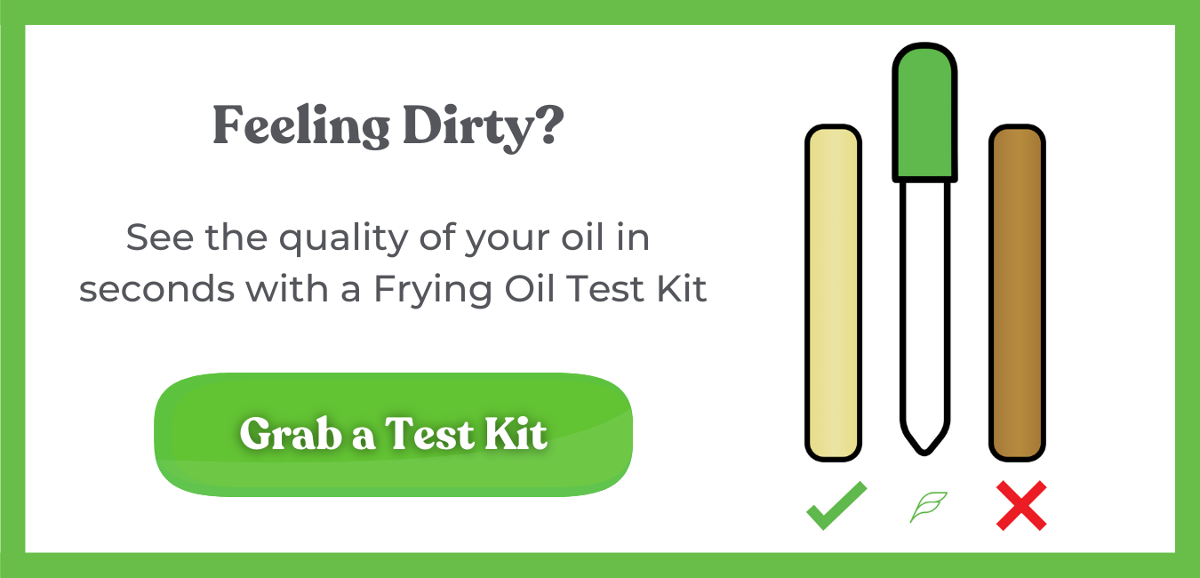Reusing Oil for Frying? Know When to Change it with These Methods.
There has always been a discussion around which method should be used in determining when deep fryer oil is “bad”. Some places will use the most sophisticated systems and equipment to determine the disposal point, while others rely on the experience of the staff.
Either way, FreshFry believes that a consistent process is always best, no matter the method. Below, we will discuss a few of the methods we have observed and point out some benefits and drawbacks of each.
Fryer Basket
In this method, the fryer basket is used to help measure how dark the cooking oil is. The employee submerges the fryer basket in oil and counts how many rows are visible. If the employee cannot count to the benchmark number of rows, then the deep fryer oil is deemed bad and needs to be changed.

Fryer Basket: An example of looking through the oil to see the correct row of wire.
Pros
Using the fryer basket method is cheap and simple. The fryer basket is already provided and the directions are straightforward.
Cons
This method has several drawbacks. First, the manager or chef must establish a reference point on the fryer basket that constitutes bad oil.
Second, the subjectivity of the test can vary based on several inputs. Oil viewed in the fryer is often darker than viewed outside the fryer. Why? The cleanliness of the fryer and kitchen lighting can affect the results of a basket test. A dirty fryer or dimly lit kitchen would not be adequate for judging oil. Another point of subjectivity arises from one employee judging oil differently than another.
Oil Test Kit
Oil test kits are used to visually compare the oil from the fryer with a predetermined reference oil. The test kit will come with one or two reference points. One reference point is considered the “sweet spot” of deep fryer oil while the other references bad oil. The test kit will also provide an eye dropper, so an employee can retrieve oil from the fryer and compare it to the color examples.
Oil Test Kit: the eye dropper on the left is oil from the fryer. The cylinder on the right is the profiled example of bad oil.
Pros
A test kit is inexpensive and a one-time purchase. The method is quick and easy.
Cons
The bad oil example that is provided with the kit may not be the same standard as your kitchen’s preference. This method is also subjective because one employee may judge oil differently than another and potentially change the oil prematurely.
FFA Test Strips
FFA test strips are long thin strips of paper that measure free fatty acids in cooking oil. A test strip is submerged in deep fryer oil at operating temperature for two or three seconds, removed, then inspected against a reference chart. If the test strip exceeds the reference point, then it is time to change the oil. Test strips need to be held in cold storage.

The test strip is submerged in oil for several seconds at operating temperature an d inspected for color change.
Pros
Test strips are accurate and quick. The strips are easy to understand and takes the guesswork out of determining when to change the oil.
Cons
Test strips are an additional cost for the kitchen. Appropriate storage is crucial because if test strips are sensitive to the environment and can give false positives. The manufacturer’s recommendation for a discard point may not be the same as the in-house preference.
Digital Cooking Oil Tester
The digital cooking oil tester measures the total polar molecules (TPM) of cooking oil. Measuring the TPM is essentially measuring the fat breakdown of the oil. This is a standard method of measuring oil life in Europe and has reference discard points at 25-27%, where literature states that frying oil containing higher TPM would have adverse health effects in humans. In operation, the employee will place the wand in the deep fryer oil (must be at least 100°F) to the appropriate depth and slowly swirl the wand until the device settles on a TPM output.

The TPM tester is dipped in cooking oil to the appropriate line until the TPM of the oil is measured.
Pros
Gives an accurate measurement of TPM +/- 2%. The tester is easy to understand and takes the guesswork out of determining the oil discard point.
Cons
These devices can cost $500-600 on average and need to be calibrated at least every 2 years. Although it is a mandatory measurement outside of the US, most US locations would find that to adhere to EU legislation would require an investment in buying more frying oil.
_______________________________________________________________________
Each method is unique, but all aim to serve the same purpose: a quick way to determine oil life and keep your food tasting delicious.
Here at FreshFry, we strive to make deep fryer oil management systems simple and repeatable. Click here to grab a FreshFry Fry Oil Test Kit for the easiest way to test your oil in seconds.

Are you ready to learn more about FreshFry Pods and oil life extension? Reach out to us today.





